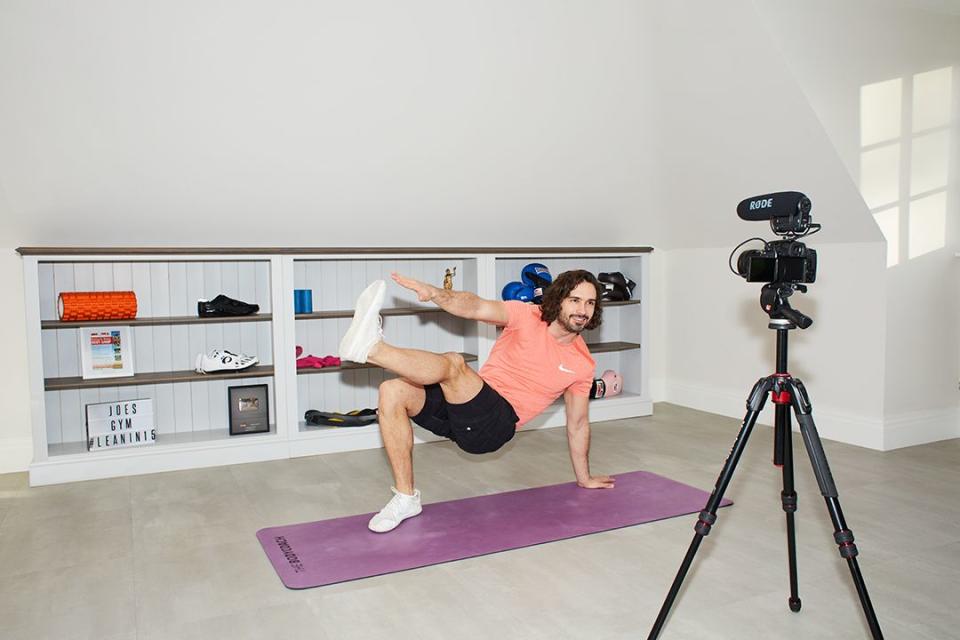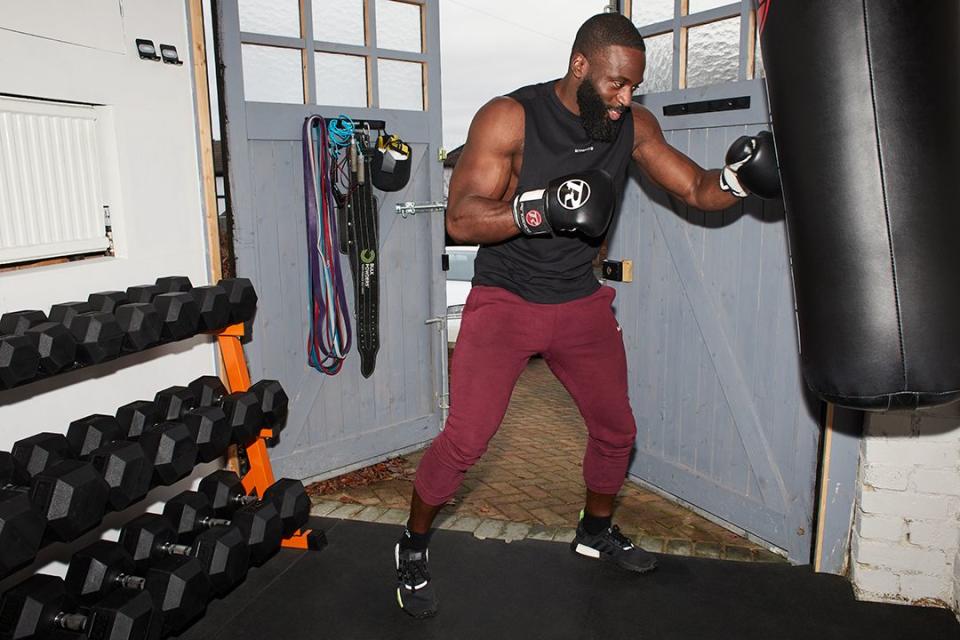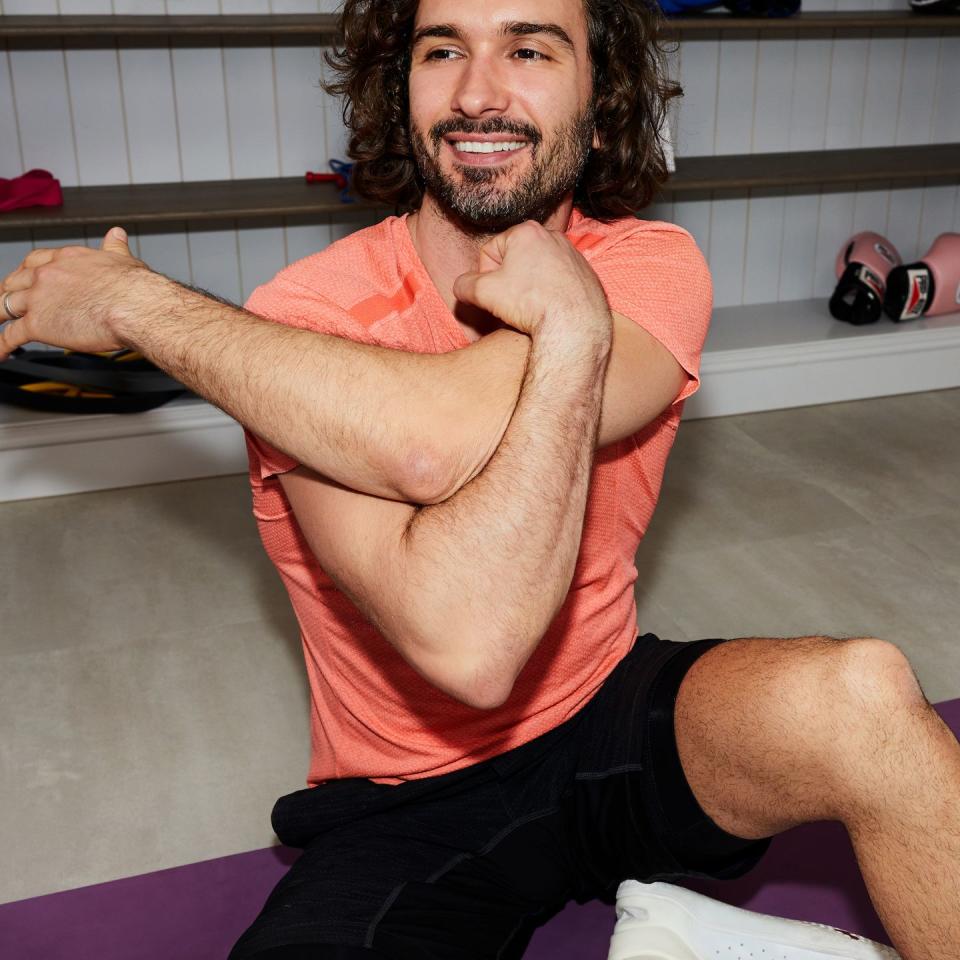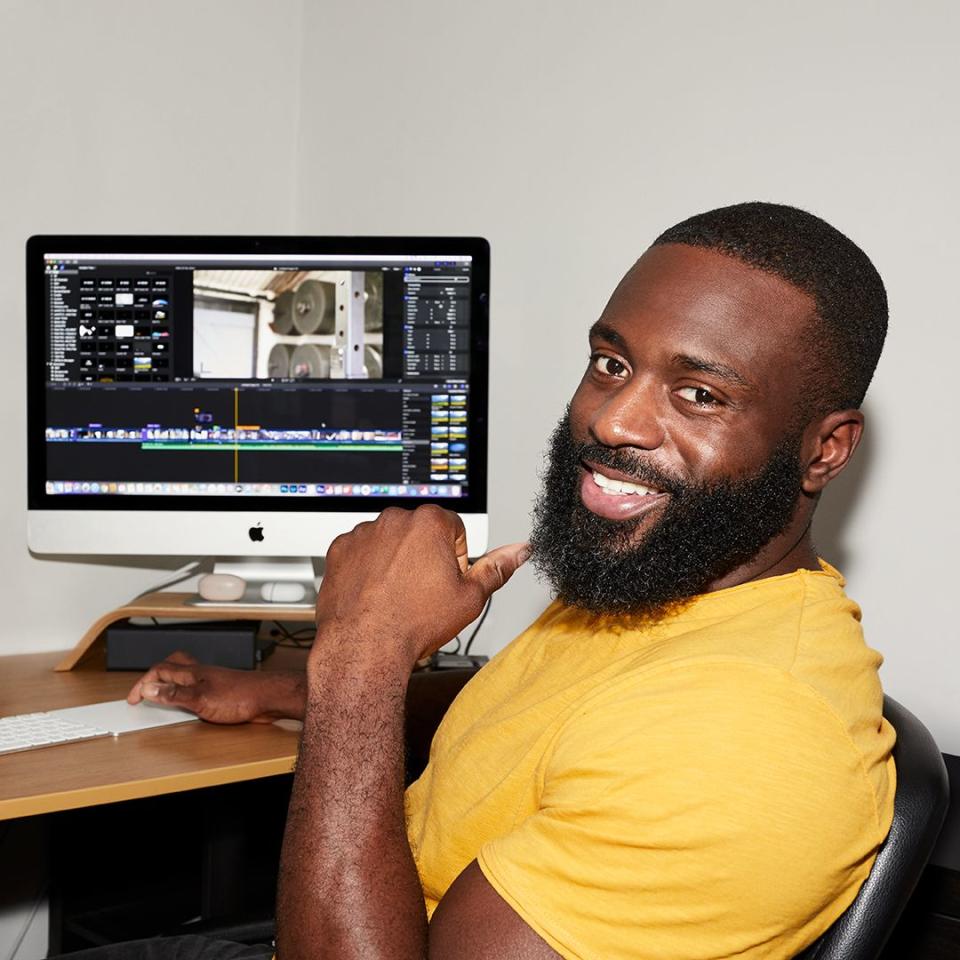Let Joe Wicks And Gabriel Sey Fix Your Workout

Joe Wicks and Gabriel Sey are reminiscing. Between being two of Britain's biggest fitness YouTubers and they've got a lot in common, but not long into their chat with Esquire, they discover they both spent their formative years behind the wheel of red Vauxhall Novas.
"That was my first car – bought it off my brother for 500 quid and crashed it," says Wicks.
"Mine had a body kit," says Sey.
Wicks sounds unsurprised. "You joker."
As we chat, Sey talks through his answers deliberately and thoughtfully, while Wicks's high-cadence Surrey patter comes in a torrent. And fair enough: he's been a very busy man since becoming the whole country's bouncily endearing next door neighbour.
In late March the first of his PE With Joe workouts was broadcast live to more than 900,000 households. For the next 18 weeks Wicks did his thing every weekday morning, and on the way raised £500,000 for the NHS and earned an MBE. Before the pandemic he’d grafted to 800,000 subscribers over eight years; after two and a half weeks of PE With Joe he’d hit two million.
"I was nervous but I settled into it, " Wicks says. "By the end of it I was emotionally exhausted. Sometimes I didn’t really want to do it, but I had to step in front of that camera and perform and bring the energy and do it. I actually felt quite sad when It was over. I had a couple of weeks where I felt a bit lost because I had so much purpose during that time."

If Wicks is already a household name, Sey might soon be. Formerly an American footballer and a physique competitor, he now mixes fitness challenges and family fun under his Active Black Dad banner. His Bodybuilder Does Gymnastics video ("really just me falling over a lot") was a breakout hit, and right now he’s big on mobility and body positivity.
"It’s about loving yourself at the point you are, no matter what point you are, even if you are progressing to something."
Sey has been on YouTube since 2012 and Wicks since 2011, and in that time the platform has been through several decades’ worth of revolutions.
"I watched a few of my old videos and I cringed so hard," says Sey. "I was trying to be like this LL Cool J type vibe, and it was so, so cringe.”
"Obviously it’s more competitive now," says Wicks. "There used to be one KSI; now there’s loads of KSIs. There’s loads of Logan Pauls, there’s loads of Body Coaches, there’s loads of family YouTubers."

Wicks and Sey have been paired up for the platform’s initiative The Rise, which teams 10 high-profile YouTubers with 10 up and coming content makers to share advice and support, and, in Wicks’ words, “give them a little nod to say you’re doing really well, keep going”.
"YouTube’s a hard platform to grow, it’s a long old journey, and it really takes a long time and a lot of effort," he says.
They didn't get to where they are in the YouTube firmament without learning pretty much every useful workout trick in the book, and today Wicks and Sey are here to troubleshoot out all of your workout complaints. You're welcome.
I live in a flat. How can I work out without annoying my neighbours?
Joe Wicks: You can get a really great workout doing a yoga flow or doing low-impact [sessions]; you haven’t got to be jumping up and down doing burpees and squat jumps. Even getting a set of kettlebells or dumbbells: essentially it’s about controlling the weight, not dropping it, and taking your time with it. You can still have a great workout in a small space. All you need really is the size of a yoga mat and maybe one dumbbell or a couple of dumbbells.
Gabriel Seys: You did a really good job of getting those workouts into the public. A lot of that stuff doesn’t need to be high impact. I did animal flow for the first time and I was sweating buckets. Everything was hurting. I was like, this looks so easy, why is this so hard? Then I watched the video back to see if I was doing it right, and I was like: yeah, that looks awful. [In] a gym environment you see people like, ‘Grrr! Grrr!” and throwing the weights on the floor. Let’s control the weight down: you don’t need to throw a kettlebell down. The whole point of the exercise is eccentric and concentric, and both need to be controlled. Not everything needs to be box jumps and high knees.
My back hurts after months of working on the sofa. What exercise can I do to stretch it out?
JW: Yeah, regardless of what you’re doing at the moment your hamstrings will be tight, your hips will be tight, you’re not going to have a lot of rotational work going on. There’s great yoga training on YouTube; I’ve started looking for yoga, mobility and pilates work where you’re really getting to open up the joints. I don’t do enough of it – because I’ve got poor mobility, I feel a bit embarrassed that I’m fit but super-tight.
GS: I’ve definitely got a lot better. There’s still some tightness, but I’m still not at the point where if I, say, do a downward facing dog, it looks anything like it. It looks more like a scared cat.
JW: It’s going to be your hamstrings, your glutes, and sitting down all day, so just by being more active, having breaks and going for walks through the day it’s going to help things. And, if you can, get a massage. A good sports massage can unlock a lot of things.
GS: A massage gun has done wonders for me. There’s a few very basic stretches: the hang-down hamstring stretch [and] rotations of the spine unlocks a few things. When you’re sat at your desk you could be rolling a ball across your feet to reduce the tightness there, rolling it into your leg – there’s loads of little things you can do on a daily basis.
How do I stay motivated through winter?
JW: Aw, I wish I could bottle it. I’ve got a lovely home gym, and I still struggle sometimes in the winter. Not so much with the training, I still get a lot out of it, but I can’t stop eating. I have dinner, and then if I’m awake late I’ll go in the cupboard and have six Weetabix, four slices of toast. That’s the hardest thing, so I’d say focus on three meals a day, have a decent portion that’ll avoid grazing through the day. I know it’s a simple thing, but going to bed earlier, leaving my phone downstairs and getting an earlier night means I’m not in the kitchen like a raccoon going through the cupboards. Going to bed two hours earlier means I eat way less junk, I’m not drinking gin and tonics, I’m not waking up feeling moody and lethargic and bloated. Sleep more, focus on three main meals: it’s a simple way of getting healthier.
GS: Coming from a competitive background with my physique and with my American football days, I played the whole season through so my training was non-stop. But I understand there’s a lot of people that aren’t, so I guess my recommendation would be rather than stocking the cupboard with cookies and stuff, have some low calorie snacks. Sugar free jellies are literally the greatest things in the world. Hartleys do them. If you put them in the fridge, they’re amazing. I’ll eat one of those, drink some water, and be like: right, I’m cool now.

I’ve taken up running. What cross-training moves will help me get quicker?
JW: I think doing some HIIT training – incline intervals are really great – and just basic strength work. Good squats and good lunges are gonna build up your legs and build up your endurance. In Richmond Park there’s a really steep hill; I [used to] run up it, walk down, run up it, and do 10 of them. Next time I did a 10k I was definitely quicker, so it does definitely translate.
GS: If you’re doing German volume training, where you’re doing 10 sets of 10 squats – I died the first time, and was resurrected, it was horrible – that sort of stuff builds the endurance, so when you do come to run your muscles are used to being under tension for prolonged periods of time. Like Joe said, do hill sprints, or with a weighted vest. You don’t need to do squats for two hours, but those little interval things get the muscles used to being under constant tension.
How do I lose belly fat?
JW: This is my new thing, right: sleep’s just so neglected. More sleep means more energy, more energy means you’re gonna train more, training more means you’re gonna make better food choices. So it really comes back to sleep. I’ve got two kids under two so I have broken sleep, sometimes I stay up and don’t get enough sleep, and it affects my health. The quickest way to lose body fat is by getting more sleep. It’s gonna change your life.
GS: Hundred percent agree. When I talk to clients about it I’ve got a checklist. The power of self-assessment is huge. Sleep is one of the big ones, hydration is another one.
JW: I always have a Chillys bottle with me, I’m always drinking water. Like, three litres a day.
GS: You have to. Hydration is massive. Are you making healthy eating choices? Is your mindset around nutrition correct? Are you staying up too late? Are you doing everything to rebuild yourself for every day? When people say, ‘How do I lose body fat?’ you need to have everything in check. There’s no one exercise, no magic pill, no Death Becomes Her potion.
How much protein do I need?
GS: The stuff I used to follow before was one gram per pound of body weight, and I just think it’s too much. There’s a base level which is something around 0.6 to 0.7 [grams] per pound of body weight and then depending on what the goal is you might increase or lower it. But it’s so subjective. When people ask me the question, I’m like: I need to know more about you.
JW: I’m eating a lot more veggie these days – I used to eat so much egg, chicken, bacon, salmon cod, every day, every meal was meat. As long as you’re having one or two good bits of protein – a piece of salmon, or three or four eggs in the morning – you ain’t got to overthink it. You’re getting protein in oats, in nuts and all different things. Not just meat: chickpeas and lentils have a lot of protein. It’s about having a balanced diet, I’d never say it’s about hitting X amount a day. I think people should be more intuitive about how they eat really.

How do I build muscle?
JW: In a nutshell, it’s basically: eat more, lift heavier, isn’t it? It’s progression. You’ve got to eat a high amount of food and sustain that food intake, and then also progressively lift. You don’t want to get stuck on the same weights. It’s about progressively overloading the muscles so that they have to break down and grow back stronger because you’re giving them stimulus. It takes months and years to truly build muscle naturally doesn’t it, Gabriel?
GS: Yeah. I also think that the thought process behind progressive overload, a lot of people think: I need to increase the weights incrementally, [but] progressive overload is any type of progression. If you rest 30 seconds less before your next set, that’s progression. If you slow down the tempo of a weight that you had to force out, that’s progression. There’s so many markers you can hit. Progressive overload is just getting better in your exercise every time you do it. That’s what accumulates, and that’s where you see balanced growth.
How do I get a six pack? Is that even something to aim for?
JW: When I’ve done Men's Health covers, I’ve got a bit leaner, I’ve trained a bit harder, I’ve cut out the gin and tonic and the ice creams and I’ve got stripped for a couple of months. But I wasn’t happy those days. The leaner I am the more boring I am. I can’t go out for Nandos or have a curry and a beer. To truly get lean, you have to give up a lot of the foods you’ve got used to: fizzy drinks, chocolate, things you might enjoy. Ultimately, I’m OK that I’m not as lean as I’ve been, because I’m eating the foods I love and I’m fit and I’m energised. Everyone’s chasing those abs but when you get to it, you’re like ‘I can’t sustain this all year round’. It’s brutal, man!
GS: Definitely. To get a six pack you need to move more, eat less. Some people cut out a lot, some people don’t cut out anything. There are ways to do it, but it’s [about] how happy are you doing to be in that process? And the mental side of things is more important than the physical side.
JW: When you were lean, was that when you were at your most lethargic? Doesn’t it affect your mood, your energy, your sex drive?
GS: It was horrible! I couldn’t even walk up the stairs without getting tired. There’s not enough transparency around how you actually feel when you’re shredded. There’s lean and there’s shredded, and the differentiation in the media is very skewed. The feeling between those two is two different things. In general, we need to refine the process to get the best physique we can whilst keeping our best mental health.
What’s one thing you recommend doing every day to boost your fitness and happiness?
JW: I’m a big believer in a morning routine. I’ve got into cold showers, so I have one then do my workout and I feel great. I have it before breakfast, I feel energised, I achieve more and I think if you leave it ‘til the evening that’s when all the fun stuff happens.
GS: I’ve been assessing how I’ve been over the last couple of months, and every time I’m in a weird mood and that mood carries me for the rest of the day, it’s when I don’t train as soon as I can from when I’ve woken up. It can’t always happen because of the unpredictability of kids and trying to balance everything, but I try to get my workout in before nine o’clock. People underestimate how much it boosts your mood. When you speak to people who’ve been training for a while, they’ll tell you it’s almost like therapy for them. Once people start realising that, the feel-good factor trumps everything else.
Like this article? Sign up to our newsletter to get more articles like this delivered straight to your inbox
Need some positivity right now? Subscribe to Esquire now for a hit of style, fitness, culture and advice from the experts
You Might Also Like


